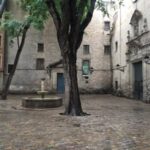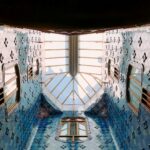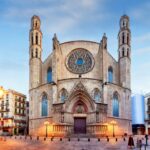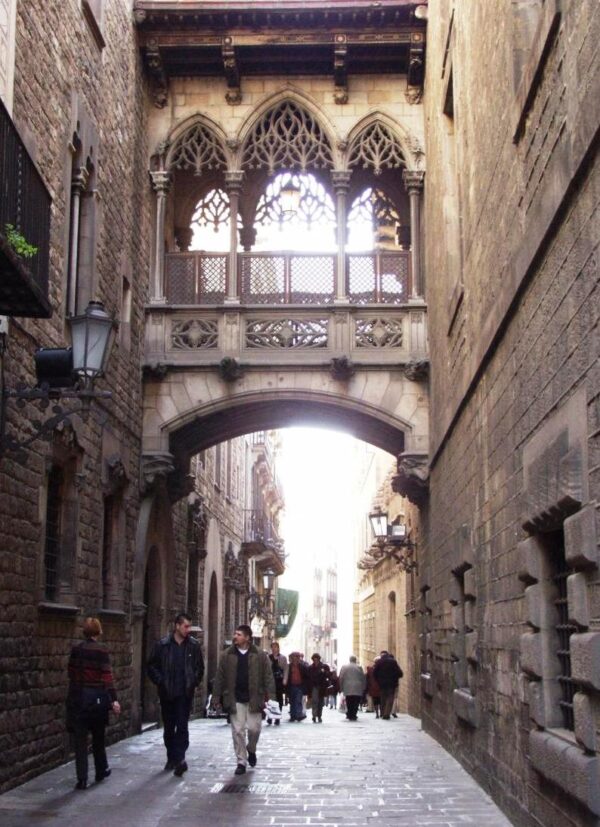
Nestled in the heart of Barcelona, the Gothic Quarter is a captivating blend of history and culture. With its labyrinthine streets and medieval architecture, it tells the story of a city that has evolved over centuries, preserving the echoes of its past.
Among its rich heritage lies the lesser-known history of its Jewish community, which thrived in this area during the Middle Ages. This historical significance is encapsulated in the phrase The Gothic Quarter: Former Jewish Neighborhood, highlighting the importance of this district as a center of Jewish life before the expulsion in 1492.
Exploring the Rich History of the Gothic Quarter: A Former Jewish Neighborhood
The Gothic Quarter, known as Barri Gòtic in Catalan, is not only a visual feast but also a testament to the rich tapestry of cultures that have shaped Barcelona. Among its most fascinating aspects is the legacy of the Jewish community, which established a vibrant presence during the Middle Ages. This neighborhood, with its narrow streets and hidden squares, served as a sanctuary for Jewish life and culture, fostering a unique blend of traditions that influenced the surrounding areas.
Walking through the Gothic Quarter, visitors can trace the remnants of this once-thriving Jewish community. Key sites include:
- The ancient synagogue, one of the oldest in Europe, which stands as a silent witness to the community's past.
- The El Call neighborhood, where Jewish merchants conducted trade and families lived side by side.
- Historic plaques that recount the stories of the Jewish inhabitants and their contributions to the city.
As you explore the narrow alleys, it's easy to imagine the vibrant markets and bustling life that once filled these streets. The architectural influences reflect a blend of Gothic and Moorish styles, symbolizing the coexistence of diverse cultures. This rich history beckons not only historians but also those who seek to understand the complex identity of Barcelona.
To appreciate the full depth of the Gothic Quarter's past, one can visit local museums that feature exhibits dedicated to the Jewish heritage of the area. Furthermore, guided tours often highlight significant events and figures, allowing visitors to connect the dots of history. This exploration reveals a multilayered narrative that enriches our understanding of Barcelona's multicultural legacy.
The Cultural Significance of the Jewish Community in Barcelona's Gothic Quarter
The Jewish community in Barcelona's Gothic Quarter played a pivotal role in shaping the cultural landscape of the city during the Middle Ages. Their presence contributed to a flourishing environment where trade, philosophy, and the arts thrived. This vibrant community fostered a unique identity that influenced not only the local culture but also the broader Catalan history.
Among the various contributions of the Jewish inhabitants, several key elements stand out:
- Economic Contributions: Jewish merchants were integral to the commercial life of the area, facilitating trade and enriching the local economy.
- Cultural Exchange: The Jewish community introduced new ideas and practices, creating a melting pot of cultural influences that enhanced the artistic and intellectual climate.
- Architectural Heritage: Their architectural styles and urban planning significantly influenced the design of the Gothic Quarter, leaving a lasting imprint on the city's landscape.
The legacy of the Jewish community is still visible in the Gothic Quarter today. Many visitors are drawn to the historical sites that commemorate this rich heritage, including the remnants of ancient synagogues and the historic streets of El Call. These locations serve as reminders of a time when Jewish life flourished, showcasing the community's resilience and adaptability amidst adversity.
Understanding the cultural significance of the Jewish community in the Gothic Quarter not only enriches our appreciation of Barcelona's history but also highlights the city's enduring spirit of coexistence. Exploring these historical narratives allows for a deeper connection to the multicultural fabric that defines modern Barcelona, making it a vital aspect of the city's identity.
Key Landmarks in the Gothic Quarter's Jewish Heritage
One of the most significant landmarks in the Gothic Quarter's Jewish heritage is the Ancient Synagogue, known as the Sinagoga Major. Dating back to the 13th century, it is one of the oldest synagogues in Europe and offers a glimpse into the spiritual life of the Jewish community. The site remains a poignant reminder of the once-thriving Jewish presence in Barcelona.
Another key landmark is the El Call district, which served as the heart of Jewish life during the Middle Ages. This area is characterized by its narrow, winding streets and hidden plazas, where merchants and families coexisted. Visitors can explore this historical neighborhood, where remnants of the Jewish past still resonate amidst the modern-day bustle.
Additionally, historical plaques scattered throughout the Gothic Quarter provide insights into the lives of the Jewish inhabitants. These informative markers recount stories of resilience, trade, and cultural contributions, creating a deeper understanding of the community's significant role in shaping the city's history. Here are some notable plaques to look for:
- The plaque at Carrer de Sant Domènec del Call, which details the establishment of the Jewish community in the area.
- A commemorative plaque at Carrer de la Sènia, honoring the Jewish merchants who once thrived here.
- Information boards near the site of the former Jewish cemetery, illustrating burial practices and beliefs.
Exploring these landmarks allows visitors to appreciate the depth of the Gothic Quarter's Jewish heritage. By walking through the remnants of ancient buildings and reading the historical context, one can gain a richer understanding of how this community influenced not only the district but also the broader narrative of Barcelona's diverse cultural landscape.
How the Gothic Quarter Reflects Jewish Influence on Barcelona's Architecture
The Gothic Quarter of Barcelona, historically known for its Jewish community, showcases a significant architectural influence that can still be appreciated today. The narrow streets and alleys reflect a design aesthetic that melded Gothic and Moorish elements, which were particularly prominent during the Middle Ages. This blend not only illustrates the coexistence of cultures but also highlights the community's adaptability in an ever-evolving urban landscape.
Jewish architecture in this area is marked by functional yet ornate designs, which can be seen in the remnants of buildings that once served communal purposes. Key architectural features include:
- Intricate stonework and arches that echo the craftsmanship of the era.
- Small, hidden courtyards that provided private spaces for family and community gatherings.
- The overall layout of the El Call district, which reflects the integration of residential and commercial spaces.
Additionally, the use of specific materials, such as local stone, ties the architectural heritage directly to Barcelona's landscape. This local craftsmanship is a testament to the Jewish community's influence, as they contributed to the rich tapestry of architectural styles that define the Gothic Quarter today. Visitors can still find evidence of this heritage in the subtle details of buildings and the layout of the streets.
The enduring legacy of the Jewish influence in the Gothic Quarter is a vital part of Barcelona's architectural narrative. By exploring this unique blend of styles, one can gain insights into the historical significance of the Jewish community and their contributions to the city's cultural identity. The Gothic Quarter stands as a living museum, where each corner reveals a piece of history waiting to be uncovered.
Discovering Hidden Gems: Jewish Sites in the Gothic Quarter
As you wander through the Gothic Quarter, you will discover numerous hidden gems that speak to the rich Jewish heritage of the area. Among these treasures is the Jewish Museum of Barcelona, which offers fascinating exhibitions detailing the history of the Jewish community from the medieval period to the present day. This museum not only showcases artifacts but also provides insights into the daily lives and cultural practices of the Jewish inhabitants.
Another notable site is the Carrer del Call, a street that was once the bustling center of Jewish life. Here, you can find remnants of ancient buildings that housed shops and homes, allowing visitors to envision the vibrant community that thrived centuries ago. The narrow lanes of El Call invite exploration, with each corner revealing stories of resilience and coexistence amidst a changing landscape.
For those interested in religious history, the ancient synagogue located within the Gothic Quarter is a must-visit. Known as the Sinagoga Major, it stands as a testament to the religious practices and spiritual life of the Jewish community. The site is not only of historical significance but also serves as a poignant reminder of the rich tapestry of beliefs that have shaped Barcelona.
Finally, the Gothic Quarter is dotted with historical markers that narrate the experiences of Jewish residents. These plaques provide a deeper understanding of their contributions to the city, highlighting significant events and figures that have left an indelible mark on Barcelona's narrative. As you explore these sites, you will gain a greater appreciation for the complex history and cultural legacy that the Jewish community has imparted to the Gothic Quarter.
The Transformation of the Gothic Quarter: From Jewish Hub to Tourist Attraction
The transformation of the Gothic Quarter from a vibrant Jewish hub to a modern tourist attraction represents a complex historical narrative. In the Middle Ages, this quarter was a melting pot of cultures, where Jewish merchants and intellectuals thrived. However, following the expulsion in 1492, the area underwent significant changes, leading to a decline in its Jewish identity. Today, the district has evolved into a bustling center for tourists, showcasing its historical charm while catering to contemporary visitors.
This shift towards tourism has brought about both positive and negative consequences. On one hand, the Gothic Quarter’s rich history has been preserved and celebrated through various cultural events, festivals, and guided tours. On the other hand, the commercialization of the area has sometimes overshadowed its historical significance, leading to concerns about the authenticity of the cultural experience. Key factors influencing this transformation include:
- Urban Development: Restoration projects have revitalized buildings, enhancing their appeal to visitors.
- Tourism Infrastructure: The establishment of hotels, restaurants, and shops has catered to the influx of tourists.
- Cultural Programs: Museums and exhibitions focus on the Jewish heritage, promoting awareness and education.
Despite the challenges, efforts to highlight the Gothic Quarter's Jewish legacy continue to flourish. For instance, the Jewish Museum of Barcelona serves as a vital resource, providing insights into the community's historical contributions. Meanwhile, initiatives aimed at preserving the area’s authentic character ensure that future generations can appreciate its diverse past. This delicate balance between honoring history and embracing tourism is crucial for the continued relevance of the Gothic Quarter in Barcelona's cultural landscape.
As visitors stroll through the quarter, they are often drawn to the stories embedded in its streets. The blend of ancient architecture and modern vibrancy invites exploration and reflection on the journey of the Gothic Quarter—once a significant Jewish neighborhood and now a symbol of Barcelona's enduring spirit of coexistence. Each visit offers a chance to connect with the layers of history that have shaped this iconic area, ensuring that the legacy of its Jewish community remains an integral part of the city's identity.
 Explore the Gothic Quarter's Hidden Gems
Explore the Gothic Quarter's Hidden Gems Casa Batlló: Interactive Immersive Experience
Casa Batlló: Interactive Immersive Experience Go right on Carrer d'Avinyó to Basilica Santa Maria del Mar
Go right on Carrer d'Avinyó to Basilica Santa Maria del MarIf you want to know other articles similar to The Gothic Quarter: Former Jewish Neighborhood you can visit the category WHERE YOU CAN GO.
Leave a Reply










Read more!